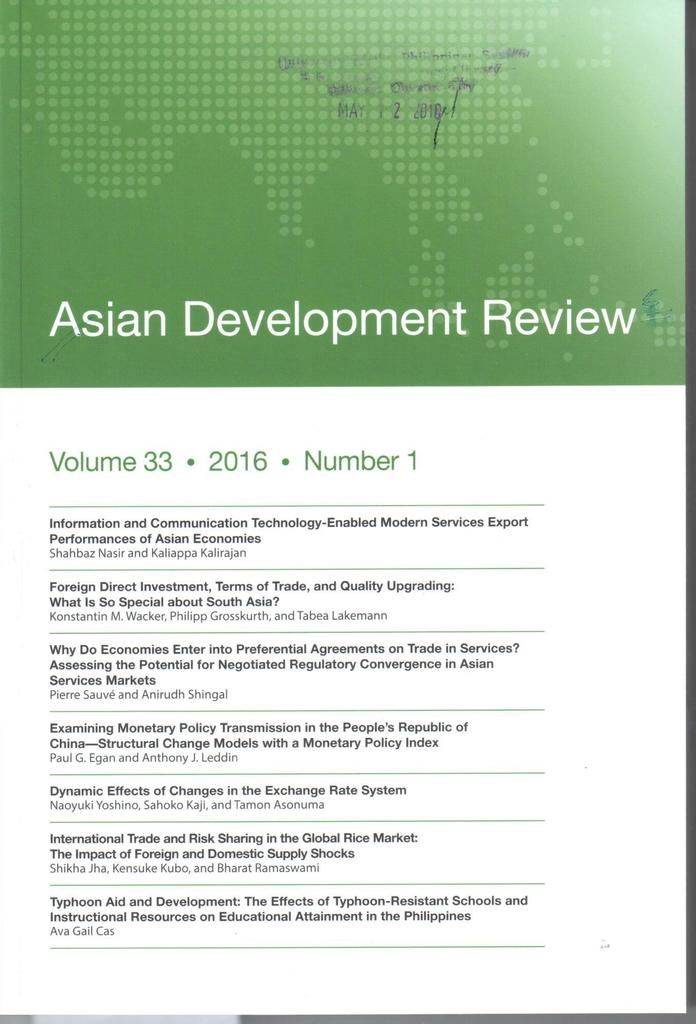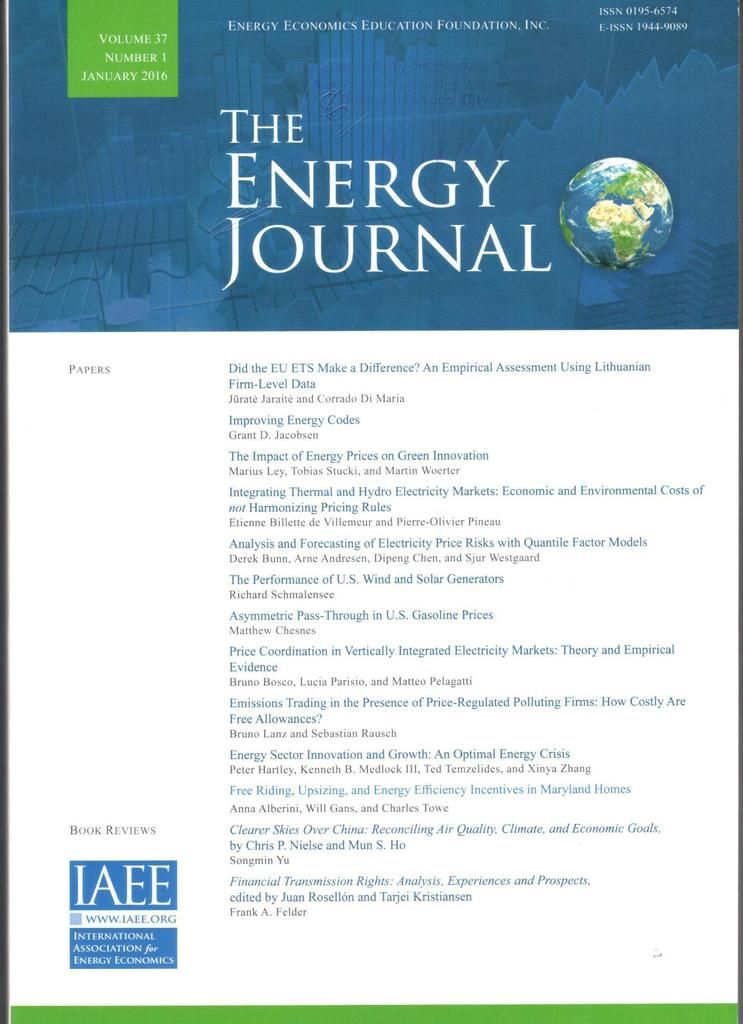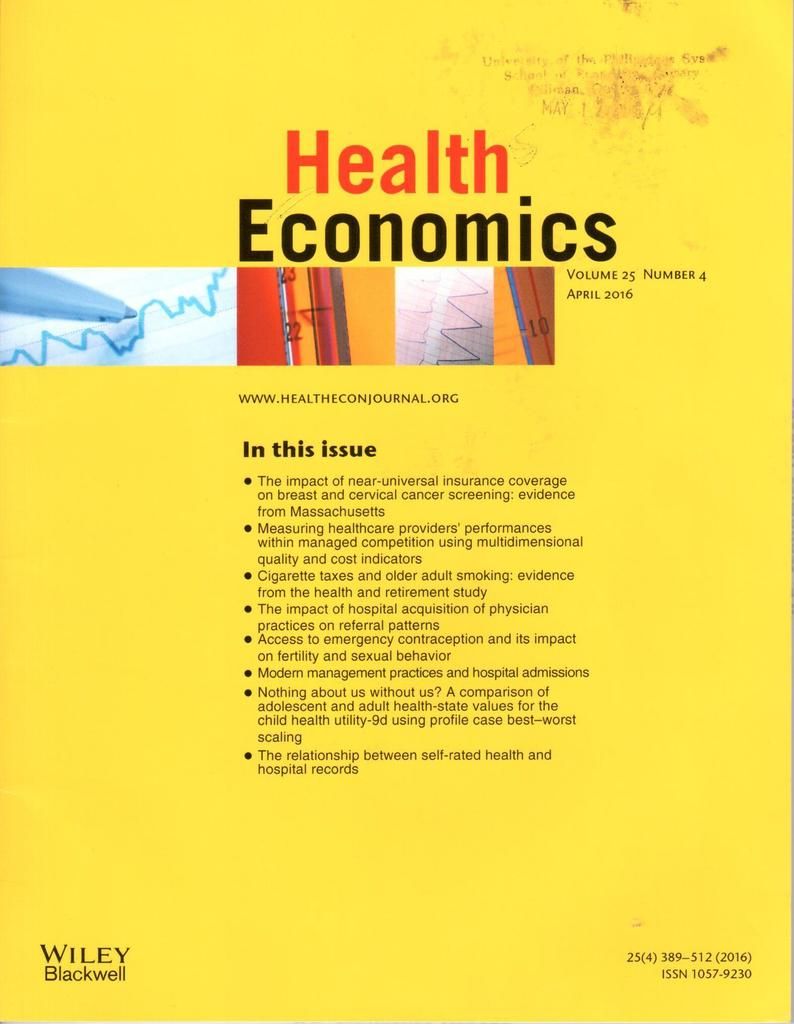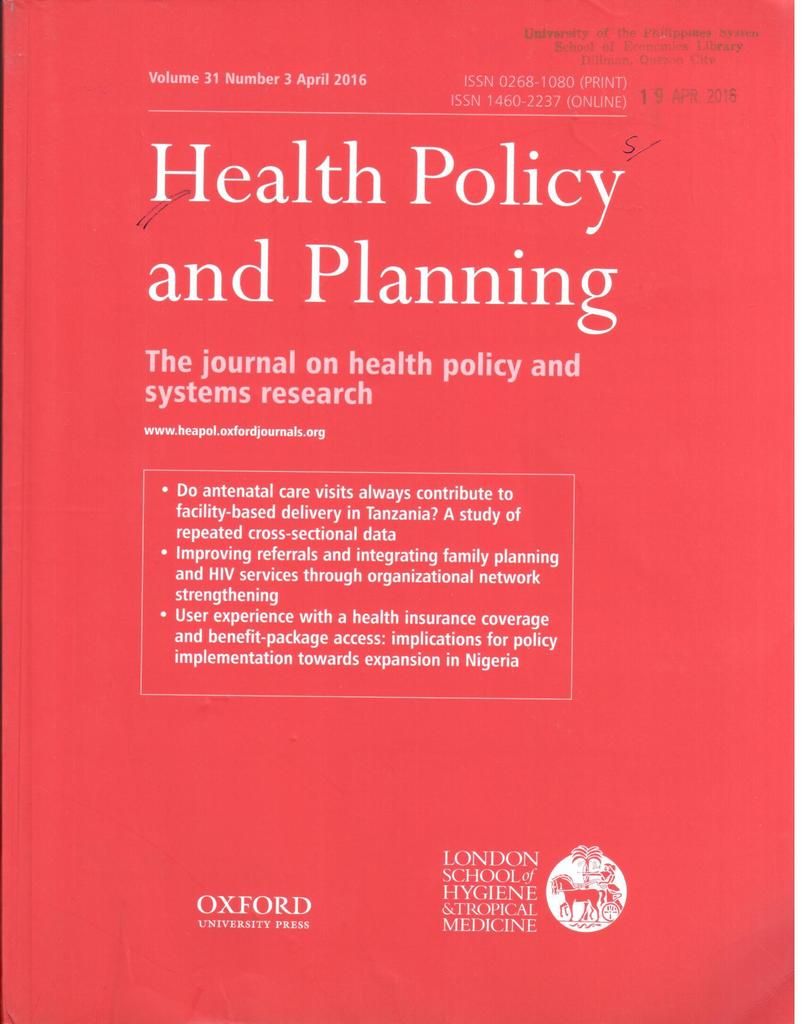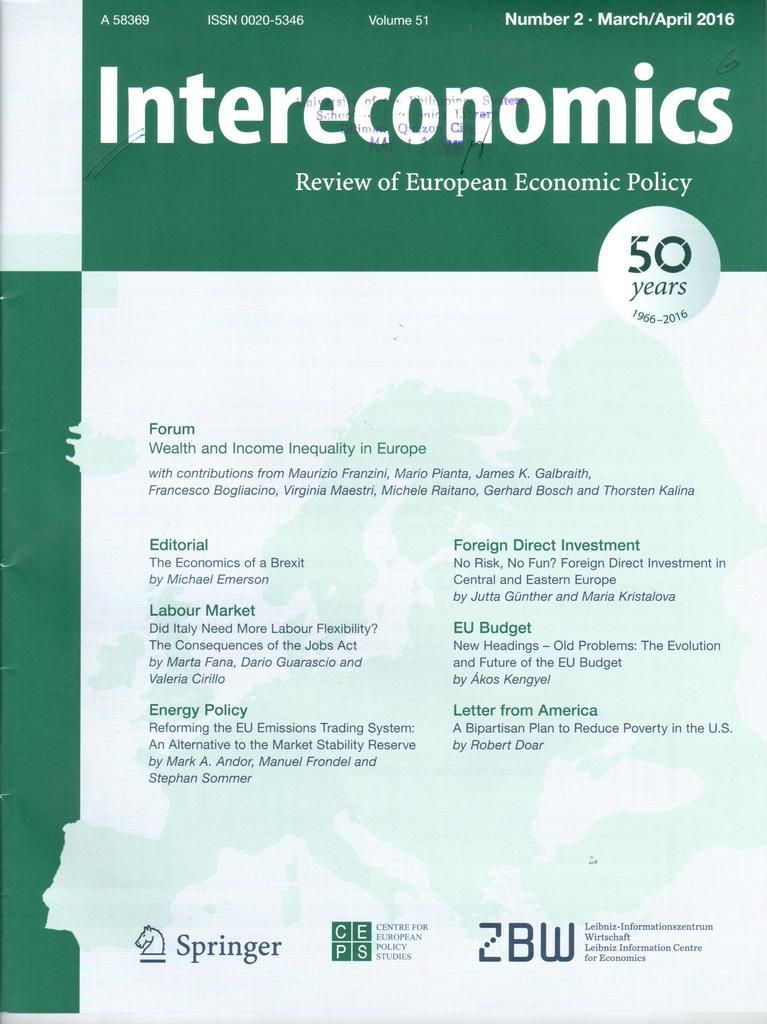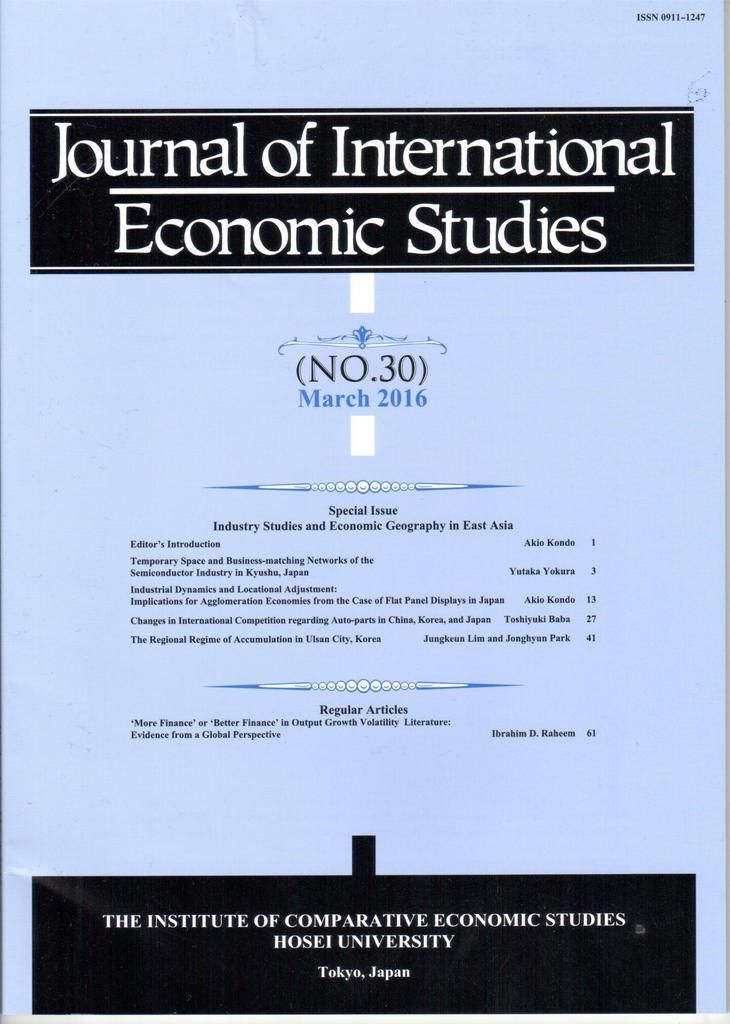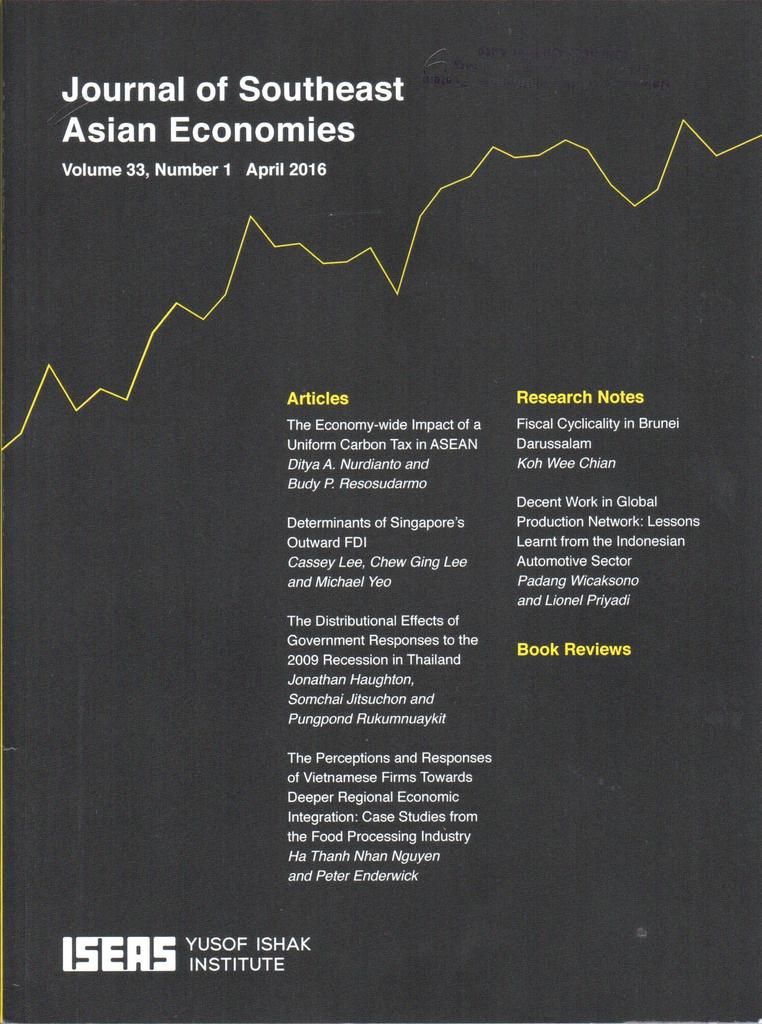Asian Development Review
Volume 33 Number 1 – 2016
Contents:
- Information and Communication Technology-Enabled Modern Services Export Performances of Asian Economies – Shahbaz Nasir and Kaliappa Kalirajan. pp. 1-27
- Foreign Direct Investment, Terms of Trade, and Quality Upgrading: What Is So Special about South Asia? – Konstantin M. Wacker, Philipp Grosskurth, and Tabea Lakemann. pp. 28-55
- Why Do Economies Enter into Preferential Agreements on Trade in Services? Assessing the Potential for Negotiated Regulatory Convergence in Asian Services Markets – Pierre Sauvé and Anirudh Shingal. pp. 56-73
- Examining Monetary Policy Transmission in the People’s Republic of China—Structural Change Models with a Monetary Policy Index – Paul G. Egan and Anthony J. Leddin. pp. 74-110
- Dynamic Effects of Changes in the Exchange Rate System – Naoyuki Yoshino, Sahoko Kaji, and Tamon Asonuma. pp. 111-161
- International Trade and Risk Sharing in the Global Rice Market: The Impact of Foreign and Domestic Supply Shocks – Shikha Jha, Kensuke Kubo, and Bharat Ramaswami. pp. 162-182
- Typhoon Aid and Development: The Effects of Typhoon-Resistant Schools and Instructional Resources on Educational Attainment in the Philippines – Ava Gail Cas. pp. 183-201
Economics of Energy & Environmental Policy
Volume 5, No. 1 – March 2016
Contents:
Electricity market reform in Japan after Fukushima
- What was the “discrepancy” in Japan’s energy policy after Fukushima nuclear crisis? – Kiyoshi Nishimura
Electricity market reform in Japan after Fukushima – Mika Goto and Toshiyuki Sueyoshi. pp. 3-14 - Wholesale and retail electricity markets in Japan: Results of market revitalization measures and prospects for the current reform – Kenta Ofuji and Naoki Tatsumi. pp. 31-50
- Responding to electricity shortfalls: Electricity-saving activities of households and firms in Japan after Fukushima – Osamu Kimura and Ken-Ichiro Nishio. pp. 51-72
- Electricity demand response in Japan: Experimental evidence from a residential photovoltaic power-generation system – Takanori Ida, Kayo Murakami, and Makoto Tanaka. 73-88
- Aiming at a Low Carbon Society in Japan by 2050: Impact of the Fukushima Nuclear Accident and CO2 Reduction Target – Tatsujiro Suzuki, Tatsuo Kobayashi, Hikaru Kobayashi, and Kazumasa Iwata. pp. 89-104
- Assessing the viability of Energy-Only Markets with 100% Renewables – Jenny Riesz, Joel Gilmore, Iain MacGill. pp. 105-130
- The Effect of Community Reinvestment Funds on Local Acceptance of Unconventional Gas Development – Naveed Paydar, Olga Schenk, Ashley Bowers, Sanya Carley, John Rupp and John D. Graham. pp. 131-59
The Energy Journal
Volume 37, Number 1 – January 2016
Contents:
- Did the EU ETS Make a Difference? An Empirical Assessment Using Lithuanian Firm-Level Data – Jurate Jaraite-Ka~ukauske and Corrado Di Maria. pp. 1-24
- Improving Energy Codes – Grant Jacobsen. pp.25-40
- The Impact of Energy Prices on Green Innovation – Marius Ley, Tobias Stucki, and Martin Woerter. pp. 41-76
- Integrating Thermal and Hydro Electricity Markets: Economic and Environmental Costs of not Harmonizing Pricing Rules – Etienne Billette de Villemeur and Pierre-Olivier Pineau. pp. 77-100
- Analysis and Forecasting of Electricty Price Risks with Quantile Factor Models – Derek Bunn, Arne Andresen, Dipeng Chen, Sjur Westgaard. pp. 101-122
- The Performance of U.S. Wind and Solar Generators – Richard Schmalensee. pp. 123-152
- Asymmetric Pass-Through in U.S. Gasoline Prices – Matthew Chesnes. pp. 153-180
- Price coordination in vertically integrated electricity markets. Theory and empirical evidence – Bruno Bosco, Lucia Parisio and Matteo Pelagatti. pp. 181-194
- Emissions Trading in the Presence of Price-Regulated Polluting Firms: How Costly Are Free Allowances? – Bruno Lanz and Sebastian Rausch. pp. 195-232
- Energy Sector Innovation and Growth: An Optimal Energy Crisis – Peter Hartley, Kenneth B. Medlock III, Ted Temzelides, Xinya Zhang. pp. 233-258
Free Riding, Upsizing, and Energy Efficiency Incentives in Maryland Homes – Anna Alberini, Will Gans, and Charles Towe. pp. 259-290
Health Economics
Volume 25, Number 4 – April 2016
Contents:
- The Impact of Near-Universal Insurance Coverage on Breast and Cervical Cancer Screening: Evidence from Massachusetts – Lindsay M. Sabik and Cathy J. Bradley. pp. 391–407
- Measuring Healthcare Providers’ Performances Within Managed Competition Using Multidimensional Quality and Cost Indicators – France R. M. Portrait, Onno van der Galiën and Bernard Van den Berg. pp. 408–423
- Cigarette Taxes and Older Adult Smoking: Evidence from the Health and Retirement Study – Johanna Catherine MacLean, Asia Sikora Kessler and Donald S. Kenkel. pp. 424–438
- The Impact of Hospital Acquisition of Physician Practices on Referral Patterns – Caroline S. Carlin, Roger Feldman and Bryan Dowd. pp. 439–454
- Access to Emergency Contraception and its Impact on Fertility and Sexual Behavior – Karen Mulligan. pp. 455–469
- Modern Management Practices and Hospital Admissions – K. John McConnell, Richard C. Lindrooth, Douglas R. Wholey, Thomas M. Maddox and Nick Bloom. pp. 470–485
- Nothing About Us Without Us? A Comparison of Adolescent and Adult Health-State Values for the Child Health Utility-9D Using Profile Case Best–Worst Scaling – Julie Ratcliffe, Elisabeth Huynh, Katherine Stevens, John Brazier, Michael Sawyer and Terry Flynn. pp. 486–496
- The Relationship Between Self-Rated Health and Hospital Records – Torben Heien Nielsen. pp. 497–512
Health Economics
Volume 25, Number 5 – May 2016
Contents:
- Addressing Missing Data in Patient-Reported Outcome Measures (PROMS): Implications for the Use of PROMS for Comparing Provider Performance – Manuel Gomes, Nils Gutacker, Chris Bojke and Andrew Street. pp. 515–528
- Copayments and Emergency Department Use Among Adult Medicaid Enrollees (pages ) – Lindsay M. Sabik and Sabina Ohri Gandhi. pp. 529–542
- Lending to Parents and Insuring Children: Is There a Role for Microcredit in Complementing Health Insurance in Rural China? – Jing You. pp. 543–558
- Has the Swap Influenced Aid Flows in the Health Sector? – Rohan Sweeney and Duncan Mortimer. pp. 559–577
- Soft Budget Constraints in Public Hospitals – Donald J. Wright. pp. 578–590
- The Effect of Medicare Eligibility on Spousal Insurance Coverage – Marcus Dillender and Karen Mulligan. pp. 591–605
- Determinants of US Prescription Drug Utilization using County Level Data – Thierry Nianogo, Albert Okunade, Demba Fofana and Weiwei Chen. pp. 606–619
- How do Hospitals Respond to Price Changes? Evidence from Norway – Jurgita Januleviciute, Jan Erik Askildsen, Oddvar Kaarboe, Luigi Siciliani and Matt Sutton. pp. 620–636
Health Policy and Planning
Volume 31, Issue 3 – April 2016
Contents:
- Do antenatal care visits always contribute to facility-based delivery in Tanzania? A study of repeated cross-sectional data – Seung-Ah Choe and others. pp. 271-284
- The enigmatic nodding syndrome outbreak in northern Uganda: an analysis of the disease burden and national response strategies – Mwaka Amos Deogratius and others. pp. 285-292
- Factors influencing modes of transport and travel time for obstetric care: a mixed methods study in Zambia and Uganda – Emma Sacks and others. pp. 293-301
- Improving referrals and integrating family planning and HIV services through organizational network strengthening – James C Thomas and others. pp. 302-308
- Behaviours and opinions towards outdoor smoking bans and cigarette littering in Baja California, Mexico – Ana C Basto-Abreu and others. pp. 309-313
- Traditional medicine for the rich and knowledgeable: challenging assumptions about treatment-seeking behaviour in rural and peri-urban Nepal – Rikke Stamp Thorsen and Mariève Pouliot. pp. 314-324
- Does the antenatal care visit represent a missed opportunity for increasing contraceptive use in Pakistan? An analysis of household survey data from Sindh province – Sohail Agha and Emma Williams. pp. 325-331
- ‘The government cannot do it all alone’: realist analysis of the minutes of community health committee meetings in Nigeria – Seye Abimbola, and others. pp. 332-345
- User experience with a health insurance coverage and benefit-package access: implications for policy implementation towards expansion in Nigeria – Shafiu Mohammed and others. pp. 346-355
- The path dependence of district manager decision-space in Ghana – Aku Kwamie and others. pp. 356-365
- Participatory planning of a primary care service for people with severe mental disorders in rural Ethiopia – Rosie Mayston and others. pp. 367-376
- Dual indices for prioritizing investment in decentralized HIV services at Nigerian primary health care facilities – Nancy Fronczak and others. pp. 377-389
Intereconomics : Review of European Economic Policy
Volume 51, Number 2 – March/April 2016
Contents:
- The Economics of a Brexit – Michael Emerson. pp. 46-47
- Forum : Wealth and Income Inequality in Europe – with contributions from Maurizio Franzini. pp. 48-77
- Did Italy Need More Labour Flexibility? – Valeria Cirillo, Marta Fana, Dario Guarascio. pp. 79-86
- Reforming the EU Emissions Trading System: An Alternative to the Market Stability Reserve – Mark A. Andor, Manuel Frondel, Stephan Sommer. pp. 87-94
- No Risk, No Fun? Foreign Direct Investment in Central and Eastern Europe – Jutta Günther, Maria Kristalova. pp. 95-99
- New Headings – Old Problems: The Evolution and Future of the EU Budget – Ákos Kengyel. pp. 100-106
Journal of International Economic Studies
Number 30, March 2015
Contents:
- Temporary Space and Business-matching Networks of the Semiconductor Industry in Kyushu, Japan – Y. Yokura. pp. 3-12
- Industrial Dynamics and Locational Adjustment:Implications for Agglomeration Economies from the Case of Flat Panel Displays in Japan – A. Kondo. pp. 13-26
- Changes in International Competition regarding Auto-parts in China, Korea, and Japan – T. Baba. pp. 27-40
- The Regional Regime of Accumulation in Ulsan City, Korea – J.K. Lim and J.H. Park. pp. 41-60
- ‘More Finance’ or ‘Better Finance’ in Output Growth Volatility Literature: Evidence from a Global Perspective – I. D. Raheem. pp. 61-68
Journal of Southeast Asian Economies
Volume 33, Number 1 – April 2016
Contents:
- The Economy-wide Impact of a Uniform Carbon Tax in ASEAN – Ditya A. Nurdianto, Budy P. Resosudarmo. pp. 1-22
- Determinants of Singapore’s Outward FDI – Cassey Lee, Chew Ging Lee, Michael Yeo. pp. 23-40
- The Distributional Effects of Government Responses to the 2009 Recession in Thailand – Jonathan Haughton, Somchai Jitsuchon, Pungpond Rukumnuaykit. pp. 41-64
- The Perceptions and Responses of Vietnamese Firms Towards Deeper Regional Economic Integration: Case Studies from the Food Processing Industry – Ha Thanh Nhan Nguyen, Peter Enderwick. pp. 65-82
- Research Notes: Fiscal Cyclicality in Brunei Darussalam. Koh Wee Chian. pp. 83-94
- Research Notes: Decent Work in Global Production Network: Lessons Learnt from the Indonesian Automotive Sector- Padang Wicaksono, Lionel Priyadi. pp. 95-110
Review of World Economics
Volume 152, Number 1 – February 2015
Contents:
- Policies for a better-fed world – Abhijit V. Banerjee. pp. 3-17
- Services versus goods trade: a firm-level comparison – Andrea Ariu. pp. 19-41
- China–US trade flow behavior: the implications of alternative exchange rate measures and trade classifications – Yin-Wong Cheung, Menzie D. Chinn, Xingwang Qian. pp. 43-67
- Recent estimates of exchange rate pass-through to import prices in the euro area – Nidhaleddine Ben Cheikh, Christophe Rault. pp. 69-105
- Exports and domestic demand pressure: a dynamic panel data model for the euro area countries – Elena Bobeica, Paulo Soares Esteves, António Rua. pp. 107-125
- Income volatility: whom you trade with matters – Marion Jansen, Carolina Lennon, Roberta Piermartini. pp. 127-146
- Spillovers from agglomerations and inward FDI: a multilevel analysis on sub-Saharan African firms – Marco Sanfilippo, Adnan Seric. pp. 147-176
- Are stricter investment rules contagious? Host country competition for foreign direct investment through international agreements – Eric Neumayer, Peter Nunnenkamp, Martin Roy. pp. 177-213
- A survey of empirical studies using transaction level data on exports and imports Joachim Wagner. pp. 215-225



